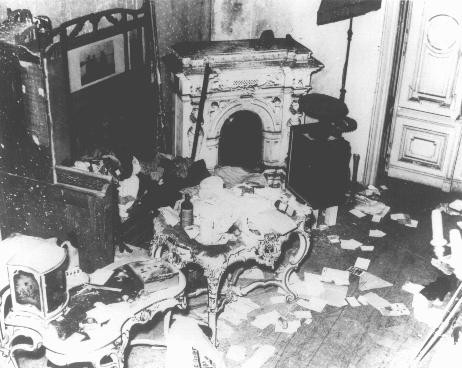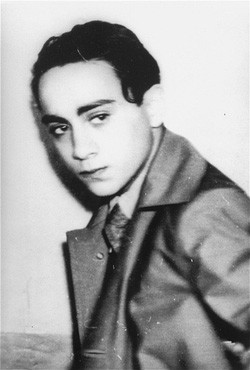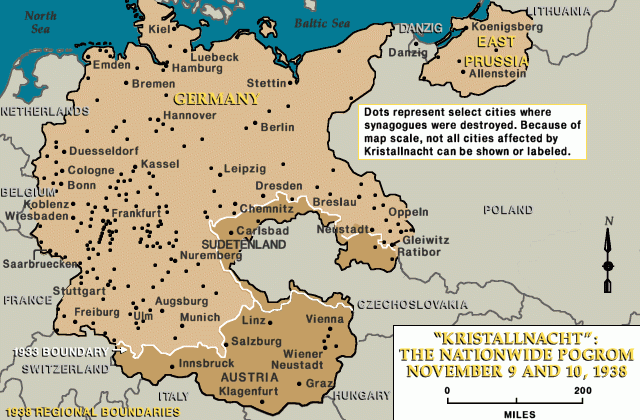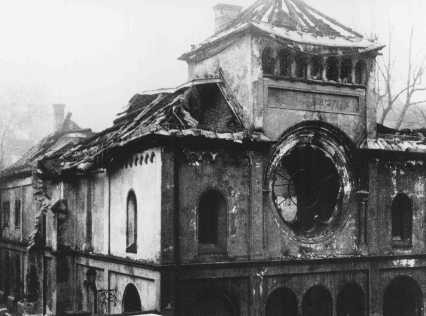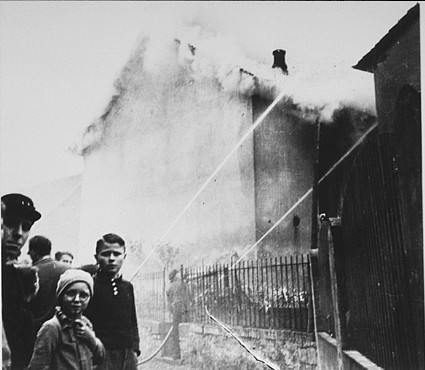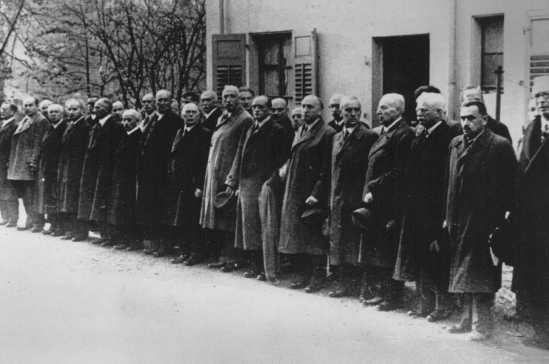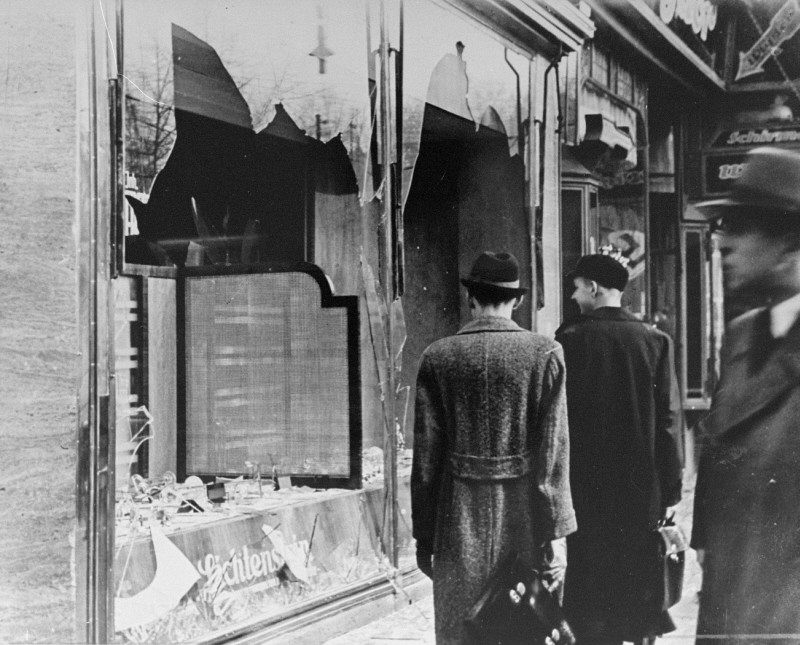
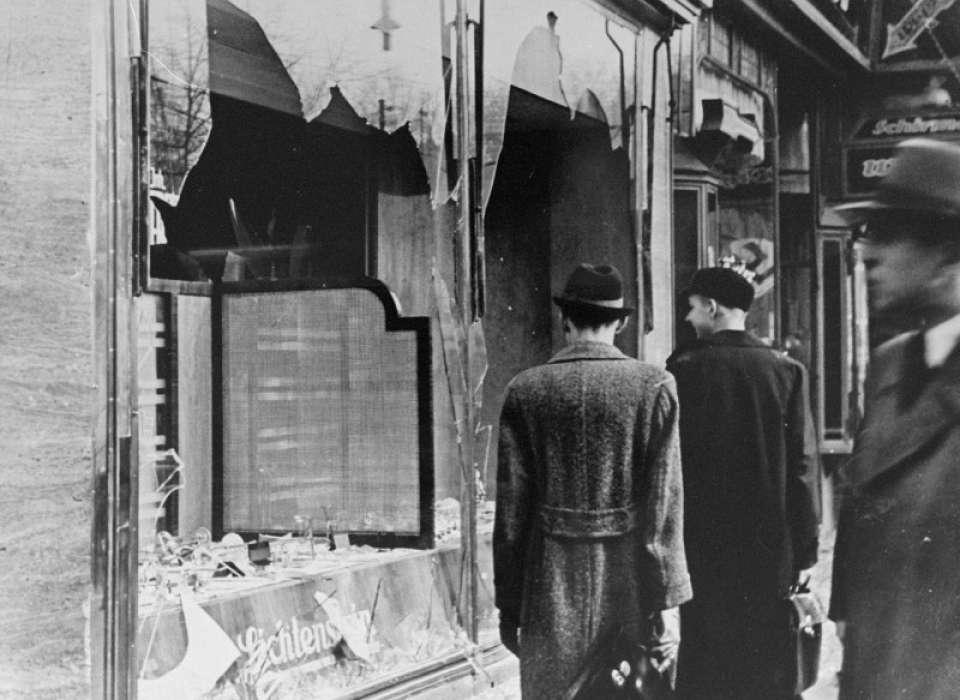
Vandalized storefront of a shop in Berlin owned by Jews, November 1938. National Archives and Records Administration, College Park, MD.
Kristallnacht, or the Night of Broken Glass, was the Nazi dictatorship’s declaration of war against German and Austrian Jews and, implicitly, against Jews living anywhere in the world. Across Germany and German-annexed Austria on November 9–10, 1938, the Nazis staged spectacles of vengeance and degradation that shattered far more than glass. For Jewish communities, the extreme hatred unloosed on them made clear, for anyone with eyes to see, that this was a regime capable of anything.
The Assassination of Ernst vom Rath
The pretext for Kristallnacht did not take place, though, inside Greater Germany. It was the assassination in Paris of a German diplomat, Ernst vom Rath, someone virtually all of the world knew nothing about before November 1938, that supplied the excuse for the devastation.
Neither was the assassin, Herschel Grynszpan, a person of stature. Only 17 years of age, Grynszpan was a young man and Polish Jew who had lived in the French capital apart from his family since 1936 and kept his head just above water financially. His decision to kill a German official had precious little to do with his tenuous circumstances in Paris. Rather, it was the despair that had built up over the situation of his family stranded on the border between Poland and Germany.
The Grynszpans, like thousands of other Polish Jews, suffered from a long-running conflict between the Nazi state and the government of Poland over the status of Polish Jews living in Germany. In late March 1938, following Hitler’s annexation of Austria, the Polish Parliament (it is often forgotten how antisemitic the Polish state became in the 1930s) ratified a law making it easier to strip citizenship from citizens of Poland living outside the country. Berlin recognized what this meant for its own efforts to pressure Jews to leave Germany. In October 1938, another Polish measure canceled the passports of citizens abroad who did not receive authorization to reenter the country. Those affected only had a few weeks to secure the requisite paperwork. In response, the Nazi leadership, with SS leader Heinrich Himmler at the forefront, first expelled male Polish Jews in Germany. This was rapidly followed by similar orders for women and children. Those deported had little time to gather valuables. To carry out the measure, the SS transported these individuals and families to the border with Poland and tried to force them across, but Poland’s border security refused to allow them. As Saul Friedländer describes it, “for days, in pouring rain and without food or shelter, the deportees wandered between the two lines; most of them ended up in a Polish concentration camp near Zbąszyń. The rest were allowed to return to Germany.”[1]
The Grynszpans had been inhabitants of the city Hannover in north-central Germany. Herschel’s sister Berta wrote to him that she had only been able to bring a small number of clothes from Hannover before the deportation and had no money when she and their mother and father arrived near Zbąszyń. Enraged, he dashed off a note to an uncle in Paris with these lines: “I have to protest in a way that the whole world hears my protest, and this I intend to do. I beg your forgiveness.”[2]
On November 7, Grynszpan went to the German Embassy in Paris. Once inside, he requested to speak with an official. Shown to the office of vom Rath, Third Secretary, he drew the revolver he recently purchased and shot him five times. The gunshots did not kill the 29-year-old vom Rath right away. French police arrested Grynszpan, and he would remain in French custody until the German invasion of France in 1940.
Once news of the shooting traveled back to Berlin, the Nazi regime exhibited restraint for a few days, something itself quite ominous. The quiet would not last long.
Vom Rath succumbed to his wounds around 5:30 p.m. on the 9th. His death was a signal for the Nazis to exact revenge. November 9–10 was already a crucial date in the history of the National Socialist movement, a time of commemoration of the failed 1923 Beer Hall Putsch in Munich. Every place with a Jewish population was to feel their wrath.
The Night of Broken Glass
Propaganda Minister Joseph Goebbels, never short on the most venomous racism, took charge of the Third Reich’s response. Speaking to Nazi Party officials congregated in Munich to commemorate the Putsch, he indicated no police protection was to be given “the Jews” and they were to be left to the mercy of “spontaneous” acts of retribution by everyday Germans and Austrians. In reality, there was nothing spontaneous about the Night of Broken Glass. The Nazis carefully orchestrated this torrent of violence. Led by the SS, the elite Nazi organization, and the SA, the stormtroopers, the Hitler dictatorship dispensed a collective punishment on all Jews for the actions of Grynszpan. During the night of November 9–10, all the antisemitic poison poured out of the Nazi system. In the darkness of what must have seemed an endless night, Jewish property and lives experienced hell in countless villages, towns, and cities.
On November 11, The New York Times chronicled exactly what happened as part of Kristallnacht in Munich. Kaufingerstraße, “one of Munich’s main streets,” the article relayed, “looked as if it had been raided by a bombing plane.[3] A half-dozen of the best shops were converted into wreckage overnight with plate-glass windows splintered on the pavement and shelves torn down, and goods lying broken and trampled on the floor.” The piece told of the torching of an Orthodox synagogue and an adjacent Jewish school and the burning of businesses owned by “Aryans” that had once been the property of Jews. The home of a Jewish manufacturer, Karl Boch, was set flame and he was arrested, as were the surgeons, Josef Rosenbaum, Alfred Haas, and M. Klar. The report mentioned that police had already taken into custody some 400 men and a half-dozen women.
David Buffum, the US consul in the Saxon city of Leipzig, admired for its trade fairs and printing industry, produced a report about the violence there that was utilized during the Nuremberg Trials and is often anthologized.[4] There is good reason for the text’s ubiquity in the literature on Nazism. His report is a compendium of all-too-real nightmares. Buffum described the night of November 9–10 in Leipzig as “the most violent debacle the city had probably ever witnessed.”(106) He disputed the utterances of Goebbels, who praised the attacks on Jews as a “spontaneous wave of righteous indignation throughout Germany.”(106) These were thoroughly top-down assaults on Jewish bodies, property, and sites of community and culture, Buffum insisted. Though chilling, the details he recorded must not be forgotten:
At 3 A.M. November 10, 1938 was unleashed a barrage of Nazi ferocity as had had no equal hitherto in Germany, or very likely anywhere else in the world. . . . Jewish dwellings were smashed into and contents demolished or looted. In one of the Jewish sections an eighteen-year-old boy was hurled from a three story window to land with both legs broken on a street littered with burning beds and other household furniture and effects from his family’s and other apartments.(107)
Buffum felt confident enough in statements from a confidential source that the “debacle was executed by SS men and Storm Troopers not in uniform, each group having been provided with hammers, axes, crowbars, and incendiary bombs.”(107) Wishing for his superiors to understand that not all non-Jews knuckled under to this terror, Buffum passed on a story about three unnamed “Aryan professors” at the University of Jena arrested for speaking out against the anti-Jewish violence.(109)
A SA report from Darmstadt confirms that Buffum was right to trust his source. The document details how “all the Jewish synagogues” within an area about 700 square miles south of Frankfurt am Main “are to be blown up or set on fire. Neighboring houses occupied by Aryan population may not be damaged. The action is to be carried out in civilian clothes. Rioting and plundering are to be prevented.”[5]
In Frankfurt am Main itself, in Hesse, Jewish wine merchant Oskar Wiesengrund endured a revolting series of events. His son, the famed Marxist theorist Theodor W. Adorno, then living in New York City, detailed everything in a February 1939 letter to his friend and fellow Marxist critic, Walter Benjamin. “We did succeed,” Adorno related, “in getting my father out of prison, but he suffered further injury to his already bad eye during the pogrom; his offices were destroyed, and a short time afterwards he was deprived of all legal control over his property.”[6] His 73-year old mother, who was not Jewish, did not escape the upheaval. The Nazis held her for two days. Receiving vital assistance from friends in the United States, Adorno was lucky enough to get an entry visa for his parents to relocate to Cuba. From there they would make it to the United States. Adorno’s efforts to do something similar for Benjamin in the summer and fall of 1940, tragically, did not succeed.
On the morning of November 10, Peter Fröhlich, a teenager from a Jewish family in Berlin, rode his bicycle and “pedaled through a city that seemed to have been visited by an army of vandals.”[7] During the night, his father had sought shelter with a dear friend, Emil Busse. Knowing his father was safe, Peter passed several specialty shops owned by Jews. “Their facades had been efficiently reduced to rubble, their huge display windows shattered, their mannequins and merchandise scattered on the sidewalk.”[8] When he laid eyes on his Uncle Samuel and Aunt Hede Fröhlich’s store selling women’s apparel on Olivaer Platz, the scale of the damage shocked Fröhlich. It looked “as though the store had been swept by a hurricane,” he recalled.[9] The Night of Broken Glass hastened the Fröhlichs’ decision to leave Germany. After they immigrated to the United States, Peter would forge an astonishing career as Peter Gay, a brilliant and influential historian of so many things the Nazis hated: the Enlightenment, the culture of the Weimar Republic, and Sigmund Freud and psychoanalysis.
Similar, even bloodier, episodes played out throughout Greater Germany. Nazi thugs bludgeoned or shot Jews to death and administered beatings of individuals in front of their families. All of this carnage added up to a gruesome toll. Nearly 100 Jews were murdered, and many others took their own lives. Nazi security forces rounded up some 30,000 male Jews and shipped them to concentration camps at Sachsenhausen, Dachau, and Buchenwald. Incarceration in these camps was intended to intimidate Jews into emigrating (another wave of Jewish migration out of Germany did occur in the months after Kristallnacht). Roughly 250 synagogues in Germany and Austria burned. Innumerable cultural treasures were demolished.
As the United States Holocaust Memorial Museum points out, President Franklin D. Roosevelt decried the Night of Broken Glass and recalled Hugh Wilson, the US ambassador to Germany.[10] Roosevelt largely acted alone, however. A continuation of appeasement, most governments did not do anything to question the savagery against Jews just witnessed in the Third Reich.
Vichy authorities turned over Grynszpan to the Germans in 1940. Details of his time in Nazi hands are murky. Imprisoned in Berlin for a period, he was transferred to Sachsenhausen concentration camp. Goebbels made special plans for the young man. He wished to stage a show trial wherein he would try not only Grynszpan but indict Jews everywhere for their “crimes” against civilization. For decades, it was believed he did not survive World War II. In late 2016, Christa Prokisch, an Austrian archivist, and Armin Fuhrer, a German historian, claimed to have discovered in Vienna’s Jewish Museum a photograph from July 1946, almost certainly showing, they contend, a 25-year-old Grynszpan in a camp for displaced persons in Bamberg, Germany. The claim has ignited conversation about whether and how Grynszpan evaded death at the hands of the Nazis and what became of him after the war.
War indeed soon blotted out Europe’s horizon, and the Night of Broken Glass would come to appear to many as the first act in a story of antisemitism and annihilation that surpassed everything previously recorded and transmitted.
